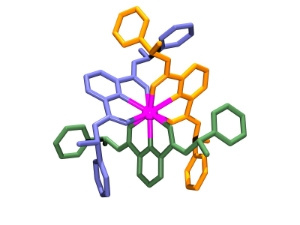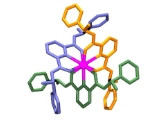
Professor Muller leads a research group comprised of 10 undergraduates and two graduates. The team created this lanthanide compound.
Have you ever wondered how an MRI machine uses a magnetic field and radio waves to create detailed images of the body?
Key to the process is the lanthanide series of the periodic table, the fifteen metallic chemical elements with atomic numbers 57 through 71.
Department of Chemistry Chair Gilles Muller does research that helps biochemists understand how molecules interact with other molecules in the body using the lanthanide series as probes.
“The reason why we study lanthanides is because when you excite them with a certain wavelength, or a light of a certain color, they emit another wavelength or color,” he said.
Muller studies these emissions using circularly polarized luminescence spectroscopy, a technique that uses lasers to determine the configuration and interaction between compounds and biomolecules.
Thanks to the National Institutes of Health and other grants, Muller leads a dynamic research group comprised of 10 undergraduates and two graduates focused on polarized light and the potential for biomedical applications.
Interested in joining the team? You can learn more on Muller’s research on his website.
Mentoring students
“It’s been really nice getting to learn more about the research process and how you put on your own individual projects,” said chemistry masters student Victoria Chang. “Dr. Muller designed it in such a way that I will get to learn how to use different instruments and methods that I’m learning will be applied to the future.”
In 2008, Muller won the Henry Dreyfus Teacher-Scholar Award for his dedication as an outstanding teacher and mentor for undergraduate scholarly research.
“The most rewards come from seeing that at some point, I have made a contribution to my students’ futures,” Muller said. “We are an institute where faculty and students work very close and that’s why I came to SJSU.”

